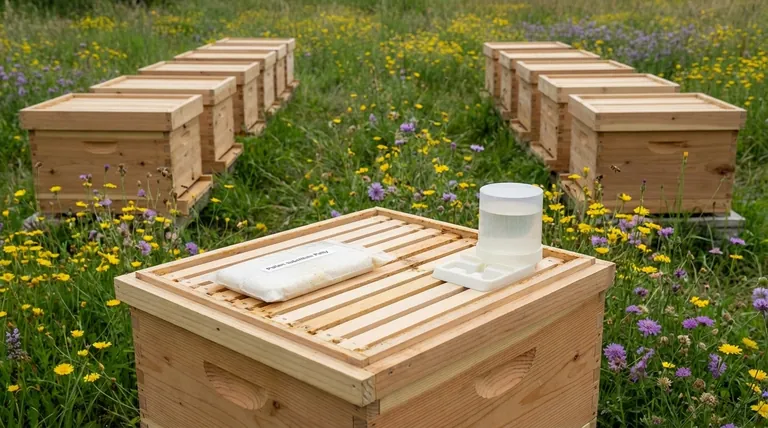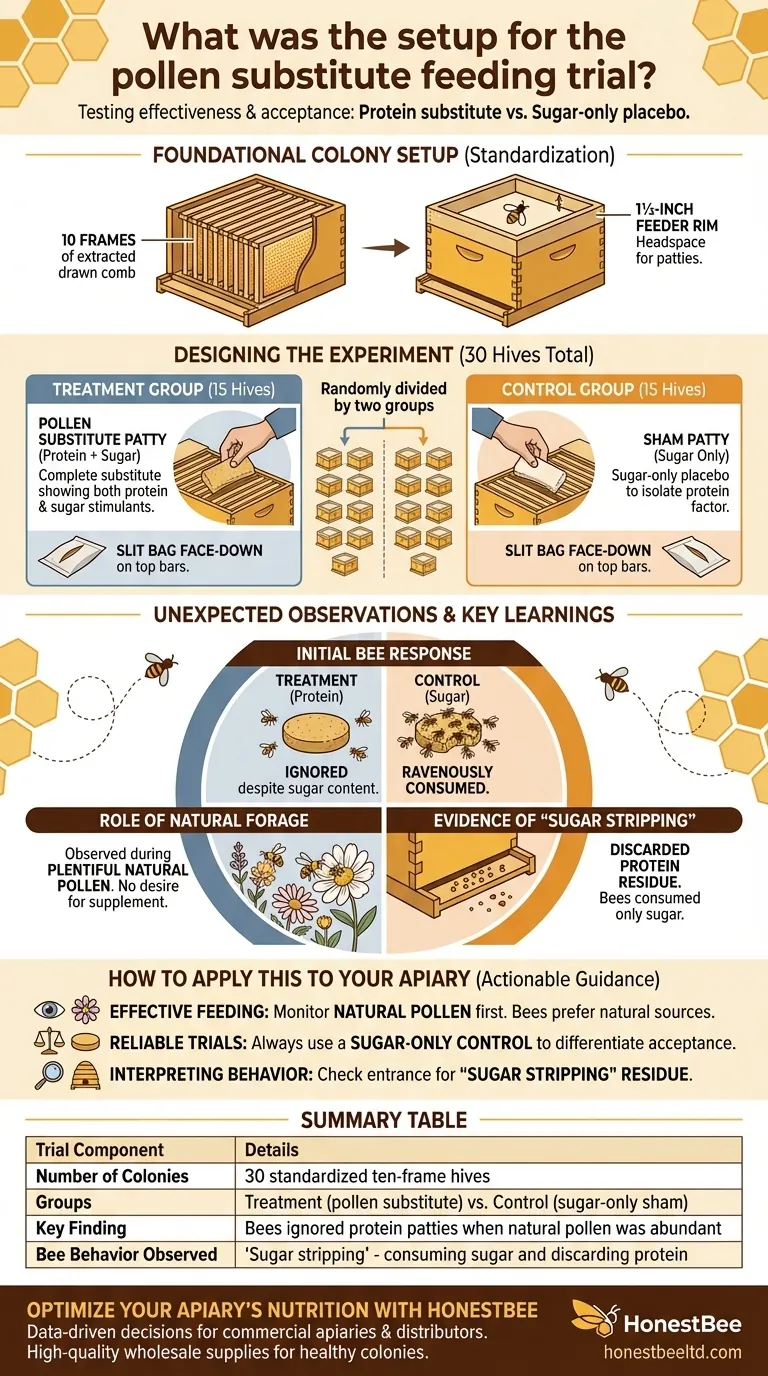The experimental setup was designed to rigorously test the effectiveness and acceptance of a pollen substitute. The trial used 30 standardized ten-frame colonies, which were randomly divided into two groups: a treatment group that received pollen substitute patties and a control group that received sham patties containing only sugar.
This trial was structured to compare a protein substitute against a sugar-only placebo. However, the key insight was not about the substitute itself, but about how bee behavior and nutritional needs are dictated by the availability of natural pollen.

Foundational Colony Setup
To ensure the results were reliable, each colony was standardized before the experiment began. This creates a consistent baseline and removes variables that could otherwise skew the data.
Standardizing the Hives
The trial began with 30 colonies. Each hive was configured with 10 frames of extracted drawn comb, providing a uniform internal environment and population potential across the entire experiment.
Accommodating the Feed
A 1½-inch feeder rim was added to the top of each hive body. This simple piece of equipment creates the necessary headspace between the top bars and the inner cover, allowing for the placement of a feed patty without crushing bees.
Designing the Experiment: Treatment vs. Control
A successful trial depends on isolating the variable being tested. In this case, the variable was the protein component of the pollen substitute.
The Treatment Group
Half of the colonies were randomly assigned to the treatment group. These hives received the complete pollen substitute patties, which contained both protein and sugar stimulants.
The Control Group
The other half of the colonies served as the control group. They received "sham" patties made only of sugar. This is a critical control measure that allows you to determine if the bees are consuming the patty for its protein content or simply for its sugar content.
The Application Method
The pollen substitute was placed directly on the top bars of the brood frames, under the crownboard. To apply it, the bag containing the patty was slit open, and the slit side was laid face-down across the frames, giving the bees direct access.
Unexpected Observations and Key Learnings
The most valuable data from a trial often comes from unexpected outcomes. The bees' reaction highlighted a critical principle of supplemental feeding.
Initial Bee Response
Surprisingly, the bees in the treatment group largely ignored the pollen substitute patties, despite their sugar content. In contrast, the control group bees ravenously consumed the sugar-only sham patties.
The Role of Natural Forage
This behavior was observed during a period when natural pollen was plentiful. The bees' lack of interest in the protein patty strongly suggests they have no desire for supplemental protein when they can collect sufficient natural sources.
Evidence of "Sugar Stripping"
Researchers observed residues of the pollen substitute being discarded at the entrances of the treatment hives. This indicates the bees may have been consuming the patty only for its accessible sugar, while removing and discarding the protein component they did not need.
How to Apply This to Your Apiary
These findings provide clear, actionable guidance for beekeepers considering supplemental feeding. Your decision should be based on observation, not just the calendar.
- If your primary focus is effective supplemental feeding: Monitor natural pollen availability before providing protein substitutes, as bees will likely ignore them if natural sources are abundant.
- If your primary focus is conducting a reliable feeding trial: Always use a sugar-only control group to differentiate between genuine protein acceptance and simple sugar consumption.
- If your primary focus is interpreting feeding behavior: Check the hive entrance for discarded patty residue, as this is a clear sign that the bees are only "sugar stripping" the feed and do not need the protein.
Ultimately, understanding your bees' response to supplemental feed requires observing their behavior in the context of their immediate environment.
Summary Table:
| Trial Component | Details |
|---|---|
| Number of Colonies | 30 standardized ten-frame hives |
| Groups | Treatment (pollen substitute) vs. Control (sugar-only sham) |
| Key Finding | Bees ignored protein patties when natural pollen was abundant |
| Bee Behavior Observed | 'Sugar stripping' - consuming sugar and discarding protein |
Optimize Your Apiary's Nutrition with HONESTBEE
Are you a commercial apiary or beekeeping equipment distributor looking to make data-driven decisions about supplemental feeding? The trial's findings show that effective feeding depends on understanding bee behavior and environmental conditions.
At HONESTBEE, we supply the high-quality beekeeping supplies and equipment you need to support healthy, productive colonies. Our wholesale-focused operations ensure you get reliable products for large-scale success.
Let's discuss how our solutions can benefit your operation: Contact our expert team today to get tailored advice and pricing for your specific needs.
Visual Guide

Related Products
- HONESTBEE Entrance Bee Feeder Professional Hive Nutrition Solution for Beekeeping
- HONESTBEE Professional Entrance Bee Feeder Hive Nutrition Solution
- Classic Wooden Bee Brush with Double-Row Boar Bristles
- High Performance Plastic Queen Excluder for Beekeeping and Apiary Management
- Premium Wood Framed Metal Wire Queen Bee Excluder
People Also Ask
- What is a common problem with hive front feeders? Avoid Robbing Frenzies and Protect Your Hives
- What is the best feeder for bees? Choose the Right Feeder for Your Hive's Success
- How to make an entrance feeder for bees? A DIY Guide for Safe & Effective Feeding
- Are entrance feeders good for bees? Prioritize Hive Health Over Convenience
- What is an entrance feeder? A Guide to Its Simple Design and High Robbing Risk



















